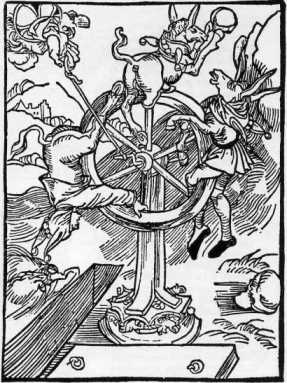The Donkey’s Mass, The Donkey Festival (or Festa dei Folli, known as the Festa dei Pazzi in Florence) was celebrated in the church in different regions of Europe, on the day of the Circumcision of the Child Jesus (on the first of January – see Holy Foreskin); but the date in question varied so could fall to Epiphany or January 14 (see Jean-Baptiste Thiers “Mémoires pour servir à l’histoire de la fête des foux“)
Calends Festival
The purpose of the festival was to pay homage to the donkey who had not only kept warm Jesus in the cave, had fled with the Holy Family in Egypt, but also had brought the adult Messiah on his back in the entrance to Jerusalem.
The veneration of the Donkey was still widespread among the eartly Christians and in the Middle Ages we see Jesus Christ crucified/donkey (Alexamenos graffito )

Poorly tolerated but still practiced by the priests, the Donkey’s Mass was a mixture of the sacred and the profane, a joke that could be pushed to the mockery of the liturgy, in a parody of the mass.
It must be said that in the Middle Ages the church is not only a building where mass is celebrated: it takes place political assemblies under the aegis of the Bishop, a lot of Corporations affaires with meetings and councils for the Corporation matters . It becomes a hospital refuge during epidemics or for pilgrims or sick in search of healing, inviolable asylum of the persecuted, grave for the illustrious dead. It could happen that men entered on horseback and at least once a year a donkey in a cassock.
THE DONKEY
An ambivalent animal in the Middle Ages the donkey is a symbol of both the Good, humble, patient, mount of the Prophets and sapiential creature (the donkey of Balaam), but also of Evil: it is the donkey opposed to the ox symbol of Christianity and the Elected People beeing a “pure animal that has a bifid and non-ruminant nail”, while the pagan donkey is “impure, rumen and has a compact nail”; it is the donkey of Dionysus and then ridden by Jesus to symbolize the Christian church that triumphs over previous cultures. It is the golden Ass of Apuleius slave of the pleasures of the flesh, ignorant but curious to learn the magic.
DONKEY’S MASS
A procession left the church and returned with a donkey led up to the altar. At Mass all the faithful answered with some bray.
Hez va, hez va, hez va, hez !
Biaux sire asnes, car alez,
Bele bouche, car chantez!
For the occasion it was also written a song: Orientis partibus! The song is attributed to the archbishop of Sens Pierre de Corbeil, whose text and music we know of as contained in the “Officium stultorum ad usum Metropoleos ac primatialis Ecclesiae Sennonensis” (XIII century) preserved in Paris in the King’s library.
| I Orientis partibus adventavit asinus pulcher et fortissimus sarcinis aptissimus Hey, Hez, sir asne, hey! II Hic in collibus Sichan iam nutritus sub Ruben (1) transiit per Iordanem saliit in Bethlehem III Saltu vincit hinnulos dammas et capreolos super dromedarios velox madianeos IV Aurum de Arabia thus et myrrham de Saba(2) tulit in ecclesia virtus Asinaria (3) V Dum trahit vehicula multa cum sarcinula illius mandibula dura terit pabula VI Cum aristis, hordeum comedit et carduum triticum ex palea segregat in area (4) VII Amen dicas, asine iam satur de gramine Amen, amen itera aspernare vetera | I In eastern lands the ass arrived pretty and strong fit for bunen Hey, sir Ass, Hey! II Here on the hills of Sichan already suckled by Ruben (1) he crossed the Jordan and enters Bethlehem. III He defeats in the jump the young mule the fallow deer and roe deer higher in speed to the dromedaries of the Medes. IV The gold of Arabia the incense and the myrrh of Saba he took to the church the virtue of the donkey V While he pulls his cart many with heavy loads, his jaw grinds tough fodder. VI He eats wheat and barley and the thistle he separates the wheat from the chaff on the threshing floor VII You say “amen”, ass, all filled with grass, “amen”, “amen” once again, spurning the past. |
NOTE
* from here
1) Ruben is the first-born son of Jacob
2) the donkey entering the church symbolically enters Jerusalem or peace. The land of Saba was the land of magicians-astrologists in the Middle Ages.
3) for the initiates, the Church had abandoned the path towards esoteric knowledge, so the glorified donkey indicates a new initiation path, the way of the mad.
4) once the animals was used to husk the wheat (simply by walking on the wheat)
Sources
http://markhedsel.blogspot.it/2014/12/il-significato-arcano-della-festa-dell.html
http://www.ctonia.com/pagine/Scritti/patiboli/rituali_di_rovesciamento.htm
http://www.doctorlizmusic.com/mctcchoirs/wp-content/uploads/2012/07/Orientis-Partibus-analysis-1.pdf
http://web.mclink.it/MH0077/IlGiardinoDeiMagi/Giardino%201/cardini_asino_6.htm
https://www.mondimedievali.net/Immaginario/asino.htm
http://web.csepasca.it/lasino-del-medioevo

